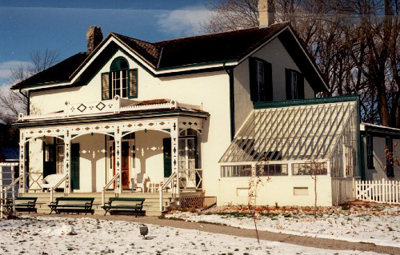Bell Homestead National Historic Site of Canada
Brantford, Ontario

Corner view
© Parks Canada Agency / Agence Parcs Canada, James De Jonge, 1997.
Address :
94 Tutela Heights Road, Brantford, Ontario
Recognition Statute:
Historic Sites and Monuments Act (R.S.C., 1985, c. H-4)
Designation Date:
1997-09-22
Dates:
-
1858 to 1858
(Construction)
-
1874 to 1876
(Significant)
Event, Person, Organization:
-
Alexander Graham Bell (Inventor)
(Person)
Other Name(s):
-
Bell Homestead
(Designation Name)
-
Bell Homestead Museum
(Other Name)
Research Report Number:
1996-018
Plaque(s)
Existing plaque: 94 Tutela Heights Road, Brantford, Ontario
Here at his parents' home in July 1874, Alexander Graham Bell conceived the fundamental idea of the telephone and, in August 1876, carried out the first successful long-distance trials. The Homestead evokes the formative influence of Bell's father, an authority on the acoustics of speech, and of his mother who was deaf. They stimulated their son's lifelong interest in teaching the deaf to speak, a passion that proved crucial to the discovery of the telephone. Since the early 20th century, the Bell Homestead has served as a symbol of this inventor's remarkable achievement.
Description of Historic Place
Bell Homestead National Historic Site of Canada is a suburban property featuring a typical mid-19th-century rural Ontario house influenced by the Picturesque aesthetic. One-and-a-half-storeys in height with a low-pitched gable roof, it features a central door, gable end chimneys, an attractive wooden front porch, a conservatory, and picturesque landscaping. Also on the lot are a wooden carriage house and a grouping of modest structures associated with the operation of the site as a museum. Official recognition refers to the homestead at the time of designation.
Heritage Value
Bell Homestead was designated a national historic site of Canada in 1934 because: it is associated with consequential events in Alexander Graham Bell's life, specifically the conception of and early long-distance trials of the telephone; it illuminates the formative influence of Bell's parents, who stimulated his interest in working with the deaf - an interest that was fundamental to the development of the telephone; it has also attained a symbolic importance as the Canadian site most widely associated with the telephone.
The heritage value of the site resides in its historical associations as illustrated by the setting and the house in its surviving original design and materials. Here at his parents' home in July 1874, Alexander Graham Bell conceived the fundamental idea of the telephone and, in August 1876, carried out the first successful long-distance trials. The Bell Homestead evokes the formative influence of Bell's father, an authority on the acoustics of speech, and of his mother who was deaf. They stimulated their son's lifelong interest in teaching the deaf to speak, a passion that proved crucial to the discovery of the telephone. Since the early 20th century, the Bell Homestead has served as a symbol of this inventor's remarkable achievement. In 1935, because of erosion of the bluff to the rear, the house and carriage house were moved forward on the lot and then placed on a new foundation, closer to the main road. Despite the loss of property over the years, including most outbuildings and an orchard, the site maintains its semi-rural setting and quiet environment. The original Bell-era conservatory was reconstructed in the 1970s, as were the house verandah and chimneys.
Sources: Historic Sites and Monuments Board of Canada, Minutes, May 1934, June 1996.
Character-Defining Elements
Key elements which contribute to the heritage value of this site include: its location on the outskirts of Brantford, Ontario; its setting on a large rural lot overlooking the Grand River; those elements which speak to its association with the Bell family, including the house with its vernacular British classical design, its centre-hall plan with a kitchen and an east wing, its stucco finish, its surviving original exterior and interior forms and materials, the carriage house with its original form and surviving materials, and the surviving suburban lot typical of 19th-century domestic landscapes; those elements which contribute to its symbolic importance, including: the relatively intact condition of the house and of the quiet, contemplative atmosphere of the property which has been maintained since the time of the Bell family occupation.